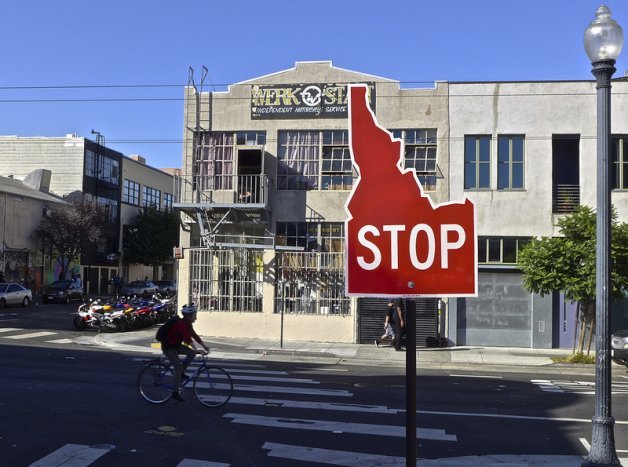Bicycles are required to follow the same laws as other drivers. However, it’s common for cyclists to roll through stop signs and red lights. This practice is criminalized in all but one State. The “Idaho Stop”, permits cyclists to roll through red lights and stop signs without stopping. But what is the Idaho Stop, and why should it be adopted everywhere?
The Reasoning
The reasoning is simple — it’s safer and statistics prove it. Bikes are moving slow enough to read traffic adequately before continuing. Underground sensors won’t trip for bikes and it slows traffic because it takes time to get bikes rolling again.
The Idaho Stop
Idaho — not always known for it’s progressive ideas — has nonetheless adopted and has been recognized nationally for it’s progressive “Idaho Stop”, law. Idaho passed its law allowing bicyclists to treat stop signs as yield signs and red lights as stop signs in 1982. Cyclists and bicycling advocates have attempted to spread this law to other states but have been met with strong resistance.
Injury Rates Decline
Since the laws inception studies have been done to prove it’s effectiveness with positive outcomes. Idaho’s Office of Highway and Traffic Safety analyzed statewide yearly summaries of traffic injuries and fatalities. The analysis found no evidence of an increase in injury or fatality rate as a result of the adoption of the “Idaho stop” law. In 1983, the year after the law was adopted, bicycle injury rates declined by 14.5 percent. Idaho has regularly been among the lowest in the rate of bike/car fatalities as a percent of population among the US.
Right of Way
A good understanding of right of way is necessary before getting into the nuts and bolts of the law. Stop signs and red lights deal with right of way. It’s all about who is entitled to it. The concept of the right of way is important but can also be confusing because the law never really grants the right of way to anyone. The law simply states when you must yield the right of way. The concept of right of way can be used when the law permits its use by requiring that others yield the right of way to you. Failure to yield the right of way leads to the most common crashes in all states.
Avoid a Crash
The point is that every cyclist, driver, motorcyclist, or pedestrian must do everything possible to avoid a crash. The law gives the right of way to no one but it does state who must give up the right of way. When you grant the right of way to another vehicle, you are letting them go before you in the traffic situation.
The Idaho Law
The Idaho law deals with the right of way, stop signs, and stop lights in this manner with it’s forward thinking Idaho Stop law, sometimes also referred to as the “Stop as Yield law”. It is as follows:
PEDESTRIANS AND BICYCLES
Stop and Go
NOT a California Stop
Since the Idaho Stop is a legal maneuver, it shouldn’t be confused with the practice of motorist rolling stops, also known as the “California stop.” This practice by a motor vehicle is never in accordance with the law and you will be ticketed or cause a crash.
Not to be Confused with Other State Laws
All other red light exceptions nationwide contain language that indicates that proceeding against a red light is appropriate when the signal fails to detect a bicyclist. Also known as the “dead red” provision, it allows those who do not trip traffic sensors –bicycles and motorcycles — to proceed through a red light. The exception in Idaho contains no such language. Check with your local jurisdictions to find out if your area has a dead red law in place.
Stop as Yield
Idaho is the only state that has both a “stop as yield” rule and a red light exception that allows a cyclist to proceed through a red light after yielding.
Strong Reactions
The “Idaho Stop” gets strong reactions within the bicycling community and cyclists should follow the rules of their State and local jurisdictions in regard to the Idaho Stop law. The reactions are typical to the difficulties of being a cyclist in a traffic system that was not designed for cyclists. You should care about the Idaho Stop law because it makes cycling easier and safer. In a world making great strides to promote cycling for health, environmental issues, and economic development, laws that make cycling easier should be international.
For Planners and Lawmakers
If you’re in a position to make laws, here’s a few good reasons why the Idaho Law Should be adopted everywhere.
- Cyclists are out in front of traffic. It increases cyclist visibility to motorists, which in turn allows drivers to operate their vehicles more conscientiously
- Cyclists visually “clearing” the intersection before the light turns green reduces the potential for collisions in the intersection
- Reduces the costs to government by eliminating the need to pay for extra sensing equipment to detect bicycles at intersections
- Because bikes pass through intersections more quickly, the overall flow of traffic improves — that should make motorists happy.
- Making bicycling easier and safer encourages people to choose this eco-friendly method of transportation
- The Idaho Stop acknowledges the role of momentum and inertia in cycling — it keeps you rolling
